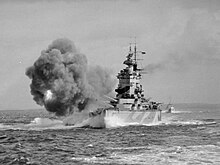Naval Gun
| Ordnance BL 16 inch Mark I | |
|---|---|
 Guns of HMS Rodney at maximum elevation, 1940 Guns of HMS Rodney at maximum elevation, 1940 | |
| Type | Naval Gun |
| Place of origin | UK |
| Service history | |
| In service | 1927–1948 |
| Used by | UK |
| Production history | |
| Designed | 1922 |
| Specifications | |
| Mass | 108 tons (109.7 tonnes) |
| Length | 61 ft 10 in (18.85 m) |
| Barrel length | 60 ft (18.3 m) L/45 |
| Shell | separate charge, AP shell |
| Shell weight | 2,048 pounds (929 kg) |
| Calibre | 16 inch (406 mm) |
| Breech | Welin |
| Elevation | 40°/-3° in mounting Mark I |
| Rate of fire | 2 rounds per minute as fitted |
| Muzzle velocity | 2,586 feet/second (788 m/s) |
| Effective firing range | 35,000 yards (32,000 m) at 32° elevation |
| Maximum firing range | 39,780 yards (36,375 m) |
The BL 16-inch Mark I was a British naval gun introduced in the 1920s and used on the two Nelson-class battleships. A breech-loading gun, the barrel was 45 calibres long ("/45" in shorthand) meaning 45 times the 16-inch (406 mm) bore – 60 ft (18 m) long.
Description
These wire-wound built-up guns had originally been planned for the cancelled G3-class battlecruiser design upon which the Nelson class drew.
Sir W. G. Armstrong Whitworth & Company at Elswick, Vickers at Barrow-in-Furness, William Beardmore & Company at Dalmuir and the Royal Gun Factory at Woolwich made a total of 29 guns of which 18 would be required for both ships at any time.


These guns broke with the example offered by the earlier 15-inch Mk I gun, which fired a heavy shell at a rather low muzzle velocity, and instead fired a rather light shell at a high muzzle velocity; this was not a success, as at the initial muzzle velocity the gun wore down rapidly and the accuracy was unsatisfactory, so much that it was lowered. Furthermore, a heavier shell was proposed but not adopted because of stringent budget policies of the 1930s; therefore, this naval gun wasn't seen as particularly successful.
Successor
An improved weapon, the BL 16-inch Mark II was designed for the Lion-class battleship which was a successor to the King George V class taking advantage of the larger weapon allowed under the London Naval Treaty from March 1938. This "new design" of 16-inch gun fired a shell that weighed 2,375 pounds (1,077 kg). Construction of first two Lion-class battleships - each of which was to have nine 16-inch guns - was halted at the start of the Second World War; only a few months after they were laid down. Work on the armament continued for a while but that was also stopped after only four guns and no turrets were produced.
See also


Weapons of comparable role, performance and era
- 41 cm/45 3rd Year Type naval gun: Japanese equivalent
- 16"/45 caliber Mk 1, 5 & 8 gun: American equivalent
Notes
- Campbell, p. 21
- Brown, p. 36
References
- Brown, David K. (2006). Nelson to Vanguard: Warship Design and Development 1923-1945. London: Chatham Publishing. ISBN 1-59114-602-X.
- Campbell, John (1985). Naval Weapons of World War II. Annapolis, Maryland: Naval Institute Press. ISBN 0-87021-459-4.
External links
- Tony DiGiulian, British 16"/45 (40.6 cm) Mark I
- Terry Duncan, British 16" Mark I Gun and Mounting
| British Commonwealth naval weapons of the Second World War | |
|---|---|
| Monitor guns | |
| Capital ship main armament | |
| Heavy cruiser main armament | |
| Secondary armament and light cruiser main armament | |
| Minesweeper, Sloop, Corvette, Frigate and Destroyer armament | |
| Submarine guns | |
| Anti-aircraft weapons | |
| Light weapons | |
| Torpedoes | |
| Anti-submarine weapons |
|
| Small craft armament | |
| Foreign-sourced weapons | |